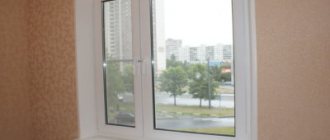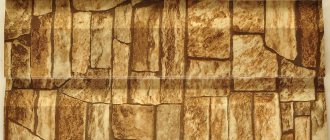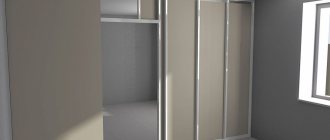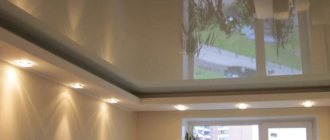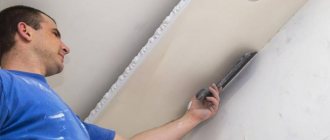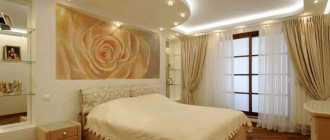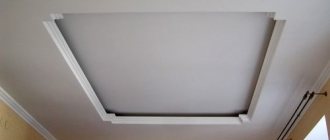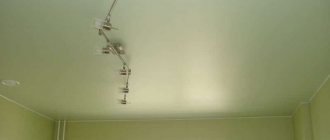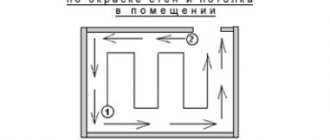Here are instructions describing the installation of a plasterboard ceiling. It is quite detailed and understandable even to those who have not encountered gypsum boards. All stages are considered - from design to rough finishing. In addition to standard techniques, you will learn some tricks to save time or money. At the beginning of the article there are lists of necessary tools and materials, as well as recommended conditions for such work. Then a brief procedure is given. And from the next section, which is called “Plan and Calculations,” a detailed description of each stage begins.
Where does the installation of plasterboard on the ceiling begin?
From wall decoration. The fact is that proper installation of drywall on the ceiling requires perfectly smooth walls. So, before starting ceiling work, the walls must be prepared for finishing (plastered and puttied). Or at least covered with plasterboard.
The future ceiling also needs to be prepared. Remove old finish if it is in the way. Secure all communications to the ceiling - wires, air ducts, pipes.
The rules for installing a plasterboard ceiling are almost the same as for installing walls. There are some difficulties. But overall, the idea is worth it, even if this is your first time encountering gypsum boards. Of course, to install plasterboard ceilings, it is advisable that you have at least some skill in handling power tools and have some physical strength.
Installation of multi-level structures
In order to install curved multi-level ceilings, the same tools and materials are used. An exception may be steep radial shapes, which will require designer arched plasterboard 6 mm thick. It bends perfectly without any tricks.
Assembling a multi-level ceiling
To increase the number of levels on the ceiling, two main techniques are used:
- First, the main plane is hemmed, and then the necessary shapes are added to it layer by layer. The disadvantages include slightly less reliability (in some places the profile is held on plasterboard, so this method is only suitable for lightweight structures) and excessive consumption of material (plasterboard fills the entire space above the levels).
- First, the boxes and lower levels are assembled, and then the highest plane is hemmed. Such a ceiling will be more durable, since all its elements are connected to the load-bearing floor, and you can also install a suspended ceiling inside, or leave the old surface, saving on material. It is inconvenient to use this method when the lower levels are not adjacent to the walls.
Decide where to stop on the spot, according to your needs.
Curved ceiling frame
To make a smooth bend in the guide profile, you need to cut it in increments of 3-5 centimeters. Depending on the mounting location, we cut through the side and front parts or both sides.
Then 27*60 profiles are also inserted into them, and the whole thing is pulled together with “bugs”.
Bend drywall
If you couldn’t find arched drywall, you can bend the existing one in two ways:
- We pierce it along the wrong side with a needle roller and soak it well in water. Then the cardboard is carefully placed on the stencil and fixed with clamps through a wooden strip so as not to push through the soaked surface. After which it dries for several days.
- An easier way is to cut through the body of the drywall in places, and smooth out the resulting angularities at the puttying stage.
The second method is much simpler and does not require making stencils, so we advise you to pay attention to it.
Assembling a straight box
Plasterboard construction on the ceiling: simplified straight box
Now we will tell you how to quickly and efficiently assemble a straight box from plasterboard.
- First of all, we mark the ceiling and walls using a tape measure, pencil and string;
- Then we wind the guide profiles along the lines;
- We cut the drywall into strips corresponding to the height of the box;
- We screw the guide profile directly on the floor to one edge of the cardboard;
- We lift the workpiece to the ceiling and fasten the other side to the ceiling guide, keeping an eye on the horizontal level;
- Next, horizontal jumpers are installed, and vertical ones at the junction of two strips;
- The structure is hemmed from below with plasterboard.
The box is ready!
If you want to make a niche for illumination with an LED strip, then the design of the box will be different.
Box with a niche for LED strip
Assembly also begins with guide profiles. Next, blanks are made from a PP profile, as in the photo above - the lower part of the profile protrudes beyond the boundaries of the box. Then a guide profile is put on them from the end, to which a small strip of drywall will be attached.
To increase the size of such a strip, the end profile can be supplemented with another one by pairing them together.
Plasterboard ceiling design: how to pair a profile
You need to arrange the profiles as in the photo above, and then fasten them together with self-tapping screws. A huge advantage of this design is that the profile serves as a good heat sink for the tape, even of high power, which will have a positive effect on its service life, and the directed light into the inner wall will be beautifully scattered.
LED strip on an additional profile
What is needed to install a plasterboard ceiling?
You will have to work with long and relatively heavy materials. You will definitely need an assistant.
The tools you will need are:
- water or laser level;
- pencil;
- marker;
- metal scissors (a grinder will do);
- perforator;
- hammer;
- knife;
- a screwdriver and several PH2 Phillips bits.
The list should be supplemented with tools and devices that will make your work much easier:
Chalk shnu
Special bit for drywall with limiter
An ordinary building level would also be useful. If you don't have a hydraulic level or a laser level and have nowhere to get them, you can get by with a regular one.
Trick: how to do without a laser level
- Secure a regular level with electrical tape to a long, perfectly straight bar;
- place the bar on a known horizontal surface;
- If the bubble is not exactly in the middle, slide a thin wedge under the appropriate end of the level. Try to perfectly align the bubble;
- rotate the bar 180°. Make sure that in this position the bubble is exactly in the middle.
So instead of a short and inaccurate level, you got a long and accurate one.
You will also need finishing tools. The list will depend on the type of finish, but in any case the following are necessary:
- spatulas - narrow and wide;
- bucket (or other convenient container).
It is advisable to have an attachment for a drill (mixer) for mixing construction mixtures.
A simple bench will help a lot. Forget about stepladders - working on them is inconvenient. Make a simple bench out of boards or roll up a simple bench out of chipboard. Calculate its height so that there is 10-15 cm above your head to the future ceiling surface.
List of materials:
- guide profile;
- ceiling profile;
- single-level connectors (“crabs”);
- longitudinal connectors (if longitudinal profiles longer than 3 meters are required);
- straight hangers (for heights up to 20 cm);
- anchor suspensions + rods (for heights over 20 cm);
- dowel-nails with a diameter of 6 mm
- or wood screws for wooden walls and ceilings (black, with a rare thread pitch);
- self-tapping screws with a press washer 4.2 x 13 mm (silver, without drill head);
- self-tapping screws for drywall (black, with frequent thread pitch)
- and the drywall itself;
- as well as putty;
- primer;
- and serpyanka.
How many materials will you need? In order to have enough, but not have any surplus, you need an accurate calculation. How to do it, read in the section “Scheme and calculations”.
Work plan
We will conditionally divide the installation of gypsum boards on the ceiling into five large stages. Next, each section of the article will describe these stages in full detail.
- Scheme and calculations;
- marking;
- installation of profiles and hangers;
- installation of drywall;
- finishing/
By measuring the room and drawing up a diagram, you will get a clear idea of how much materials will be needed.
The technology of installing drywall on the ceiling requires care. To ensure that the structure does not warp, it is necessary to accurately mark the perimeter of the room.
Let's take the hammer drill. No less care is required when securing the guide profile around the perimeter. Ceiling profiles are fastened with a screwdriver.
We lift and secure the sheets of drywall. A lot of work with a screwdriver.
All that remains is to putty the ceiling. Here it is - a perfectly flat surface on which it is convenient to apply any finish.
And now the whole process of work with all the details.
Facts about drywall
Types of drywall:
- GKL - ordinary drywall. The color of the marking is blue, the sheet is grey.
- GKVL is a plasterboard with increased moisture resistance and antiseptic properties. The color of the marking is blue, the leaf is green.
- GKLO is a material with increased fire resistance. The color of the marking is red, the sheet is gray.
- GKLVO is a plasterboard that has increased moisture and fire resistant characteristics. The color of the marking is red, the leaf is green.
The advantages of drywall include:
Physical and technical characteristics of plasterboard sheets.
- No toxic components and high environmental friendliness.
- Good soundproofing qualities, which allows it to be used in the construction of various partitions.
- Good plasticity, which makes it possible to create unusual figured structures, multi-level suspended ceilings, various alcoves, etc.
- Light weight, which allows the use of plasterboard structures in places where monolithic concrete floors and brickwork are unacceptable.
- Easy to install, working with drywall does not require special skills and knowledge.
- Drywall is a good way to quickly level a variety of surfaces. Where it is necessary to spend hundreds of kilograms of plaster and a lot of time to eliminate defects, a plasterboard sheet allows you to create a perfectly flat surface in 60 minutes.
Like any other material, drywall has its drawbacks. Compared to the advantages, they are so insignificant that plasterboard firmly holds a leading position in the building materials market. The disadvantages of drywall include:
- Fragility. Transportation and storage of drywall must be done in a horizontal position, carefully and carefully.
- Reducing the area of the room during installation by installing profiles and sheets.
Related article: How to make a wooden sun lounger with your own hands
Scheme and calculations
So, you have your walls ready. They are covered with plasterboard, ideally plastered and covered with a layer of putty. Measure every wall in the room. Very high precision is not required here; the main thing is to understand how much materials you need and how to install drywall on the ceiling (longitudinal or transverse).
Draw a diagram of the room on paper. Draw drywall sheets on a diagram to see which arrangement will produce the least waste.
Scheme for calculating the distribution of sheets on the ceiling.
The sheets should be arranged like brickwork. That is, each next row is shifted relative to the previous one by half the length of the sheet.
Dimensions of plasterboard boards
The most common size is 2.5 by 1.2 m. Sheets 2.7 or 3 m long are less common. The usual thickness is 12.5 mm, but lighter 9.5 mm is allowed for the ceiling. Although, according to Knauf technology, sheets are laid in 2 layers, which allows you to create a durable structure and get rid of cracks in the ceiling.
Now let's count the number of profiles. The technology for plasterboard ceilings is as follows: first, a metal guide profile is fixed around the perimeter. Ceiling profiles are inserted into it and attached to it. Additionally, the profiles are attached with hangers to the ceiling.
Technology for installing plasterboard ceilings
Important: guide profile installation rules
There should be no gaps between the guide profile sections. In the corner, one profile is inserted into the other until it stops. On one plane, profile sections are joined into a joint. If there is an outer corner, then one of the profile sections should stick out 27mm. In this way, a continuous belt is obtained from the guide profile.
To count the number of dowel nails, focus on the fastening approximately every 40-50 cm.
Long sections of the ceiling profile are installed exactly every 50 cm. Plasterboard boards are placed across them. Thus, the edges of each sheet will lie clearly in the middle of the profile. No edge should hang in the air! The edges adjacent to the walls will be attached directly to the guide profile.
Scheme of fastening gypsum plasterboard profiles
Jumpers are inserted across the longitudinal profiles. These are sections of the same ceiling profile, installed in increments of 60 cm. The principle is the same: all edges of each gypsum board sheet should fall in the middle of the profile. The middle of the sheet should also be secured. The length of the lintels = 50 cm minus the width of the ceiling profile (60 mm), that is, 44 cm.
Suspensions are installed along the entire length of the longitudinal profiles in increments of 60 cm.
For clarity, draw all the profiles on your diagram so as not to make mistakes in the calculation. Each intersection of the ceiling profiles is one crab and three metal screws (with a press washer).
Self-tapping screws for drywall are screwed in in increments of 15 cm . Just take the total length of all profiles in centimeters and divide it by 15.
Buy putty at the rate of 1 kg of ready-made mixture per 1 m2, approximately 3 kg per sheet . A kilogram of the finished mixture, not the powder.
Materials should be purchased with a small margin - about 20%. Quickly calculate the required amount of material for the ceiling using an online calculator.
The basis of a plasterboard structure - what is included?
Before you begin installing a plasterboard ceiling, you need to prepare the basic materials.
Considering that the structure consists of a frame finished with plasterboard sheets, for its construction you will need:
- metal profiles;
- fastening elements;
- plasterboard slabs;
- finishing materials.
Metal profiles are the basis of the structure. These should be high-quality elements made of galvanized metal in two versions: guides and ceiling carriers. To connect the profiles, a straight U-shaped suspension is used, two types of connectors are used: straight and cross-shaped. In addition, to assemble a plasterboard ceiling with your own hands you will need galvanized connecting screws and dowels.
The frame is finished using plasterboard ceiling sheets with optimal parameters: length - 2.5 meters and width - 1.2 meters. The thickness of the sheets ranges from 8 to 9.5 mm.
The classic ceiling plasterboard is painted gray. By color and thickness it can be distinguished from wall sheets, which are usually thicker. In rooms with high moisture or risk of fire, special sheets of plasterboard labeled “moisture resistant” or “fire resistant” are used.
Marking
So, we begin the actual installation of the ceiling plasterboard.
Typically, plasterboard on the ceiling is mounted strictly horizontally. Arm yourself with a level and get ready to draw a horizontal line around the entire perimeter of the room. You can limit yourself to short strokes every half meter. The main thing is that the ends of the markings meet exactly at the same level.
The correct placement of plasterboard sheets on the ceiling is important
To avoid buying tools
There is no point in buying rather expensive equipment for a one-time job. Tools such as a laser level, hammer drill and screwdriver can be rented.
You can draw a line with a pencil along a long straight bar. A piece of ceiling profile is suitable for this purpose. You can put marks only in the corners, then drive nails into them and pull the lace. But it’s even easier to stretch a chalk cord between these marks and slam it on the wall - you will be left with a perfect, straight and clearly visible line.
Using this marking you will need to install a guide profile. Remember that the finishing surface of the ceiling will be about a centimeter lower.
Next, you need to mark the installation locations of the ceiling profiles. Place marks directly on the wall, just below the guide profile attachment line. They should be visible even after installing gypsum board sheets. Apply strokes in 50 cm increments for installing long ceiling profiles, in 60 cm increments for lintels.
It remains to mark the junction of the longitudinal profile with the jumpers. Draw on metal with a marker. Place strokes every 60 centimeters on the longitudinal profiles. You can do this even before you install them in the guide profiles. Mark the ends where you started: they should all end up on one side of the room.
Installation of profiles and hangers
Drill the guide profile with a 6 mm drill bit in increments of about 40 cm. In principle, you can punch it with a hammer drill directly at the installation site. When drilling into a wall, hold the profile tightly. Make sure that it does not move relative to the markings.
Through drilling of the guide profile is allowed
If you have plasterboard walls, then you need to imagine how far away the plasterboard is from the wall. The working part of the dowel (with a notch) must sit completely in the concrete.
On walls longer than 3 m, be sure to “splice” the guide profiles by inserting one into the other. They also need to be joined in the corners. Then install the longitudinal ceiling profiles, inserting their ends into the guide profile.
Trick: how to insert a ceiling profile into the guide more easily
Use scissors to cut off the corners at the ends of the ceiling profile. This will make it much easier to insert it into the guide, especially if you are working alone.
It is best to install the hangers before you secure the longitudinal profiles and install the lintels. You just need to make sure that the profiles are exactly in place: they will guide you where to place the hangers.
For fastening into concrete, a dowel-nail is usually used. You can also take a wedge dowel - it holds much stronger, but it is also much more difficult to dismantle.
Concrete floors in old apartments are treacherous. It often happens that a drill, having traveled a little less than a centimeter, falls into the void. You can deal with such surprises in different ways:
- take a very long dowel-nail;
- attach the suspension in another place;
- Instead of a dowel-nail, drive in a wooden plug and secure the suspension with a self-tapping screw.
It is better to attach the direct suspension not to the outer holes (which are in the petals), but to the adjacent ones, located closer to the middle. Attaching it by the petals is, of course, more convenient: it’s easier to get to them when the frame is already assembled. But this method will allow the ceiling to sag a little.
You can use direct hangers even when the ceiling height from the ceiling is more than 20 cm. You just need to use two instead of one hanger.
But it is much more convenient to use an anchor suspension. The rod of the anchor suspension is attached to the ceiling in the same way as a direct suspension, through an eyelet previously bent 90° with pliers. Please note that you only need to bend the eyelet itself. The rest of the bar should remain perfectly straight.
Where to install hangers? Above each of the long ceiling profiles, in increments of about 50-60 cm. They should not fall on the junction of the longitudinal and transverse profiles! Refer to the previously applied markings.
Direct suspension
After nailing straight hangers, bend the legs 90° down. Do this carefully - after bending, the legs should remain perfectly straight.
When all the hangers are nailed, install the longitudinal profiles according to the markings (every 50 cm). Secure them with self-tapping screws through the guide profile, one at each end.
Attaching the profile to the ceiling
Screwing screws without a drill is not that difficult. The main thing is to use a suitable bat (marked “PH2”). Press firmly on the screw (but without fanaticism) and turn at medium speed. After a second or two, the sharp tip will pierce the metal, and then the self-tapping screw can be screwed in without difficulty.
Attaching the profile to the suspension
Cut the jumpers. Please note that the length of the outer jumpers will not be 44, but 47 cm. Attach the jumpers with crabs.
Ceiling crab for connecting cross profiles
The crabs are snapped on top. They have special petals with holes for fastening with self-tapping screws to the profile. Bend the petals and attach the crab with one screw to the long profile. Before doing this, make sure that it has not moved relative to the mark. Screw two more screws through the same petals into each jumper.
How to save money on crabs
Make the jumpers 6 centimeters longer. Cut the side flaps 3cm off each end. Screw the remaining middle part with a self-tapping screw directly to the long ceiling profile from below. Don’t be confused by the fact that the head of the screw sticks out a little: this will not be a serious obstacle to the tight fit of the drywall.
Options for connecting profiles without using a crab in the photo:
With such savings, the rigidity of the frame will suffer somewhat. Of course, the ceiling won't collapse; It will just be a little less smooth and durable.
Do not rush to screw straight hangers to the profile. The problem is that profiles 2 m or more in length will inevitably sag. Especially if you used an extension cord (longitudinal connector).
We eliminate the sagging using a cord stretched tightly across all longitudinal profiles:
- screw one screw into the guide profile at each end of the room, in the middle of the wall;
- tie a string to them and pull it tightly;
- you can see that the long profiles “lie” on the lace. Before securing with hangers, lift them so that they hang 1-2 millimeters above the lace.
When all the hangers and all the jumpers are screwed to the longitudinal profiles, the frame is ready. We proceed to installing drywall on the ceiling.
Video:
Installation of drywall sheets
But first you need to do insulation (if in your case it is necessary). There are different ways to insulate a ceiling. Perhaps the most convenient is mineral wool insulation. Roll insulation is simply placed on top of the frame. Wear gloves, goggles and a respirator - dust from mineral wool irritates even the skin, not to mention the mucous membranes.
And now you can screw the gypsum board sheets. Start from the edge where the whole sheet fits. Place the sheet across the long profiles, close to the walls. If you did everything correctly and accurately, then the edges of the sheet along the entire length will be exactly in the middle of the ceiling profiles.
Screw the sheet to all profiles, both at the edges and in the middle. Along the edge, the screws should go approximately every 15 cm, in other places you can increase the pitch to 20-25 cm.
How to attach sheets
GCR has a front side and a back side. On the front side there is a rounded chamfer along the longitudinal edges of the sheet and there is a slight unevenness. The reverse side is always flat - for a tight fit to the surface.
Screw in the screws ten millimeters from the edge. You need to retreat at least 15 mm from the cut edge. Retreat at least five centimeters from the corners!
The screw head should be slightly recessed into the surface of the slab. Do this carefully: the self-tapping screw is quite easy to tighten, especially if you lack experience. In such work, a special bit for drywall with a limiter is very helpful.
You can see where the profiles go by the marks on the wall. However, you can draw out a sheet of drywall in advance, even before you lift it and start attaching it. Continue the longitudinal row of sheets, end to end, without gaps. It is difficult to do this work without an assistant.
Devices for not holding a sheet of drywall
Make a support. Take a board slightly longer than the height of the ceiling, screw a piece of board about a meter long across it to form the letter “T”. Reinforce with two planks diagonally. This device, similar to a mop, is used by craftsmen all over the world when installing drywall on the ceiling.
Methods for installing a gypsum board ceiling without an assistant:
Using the lift
Homemade option for holding a sheet on the ceiling
The next row starts with half a sheet. The technology requires that the seams between the sheets do not intersect crosswise. The correct arrangement of the slabs resembles brickwork.
How to cut drywall sheets
With a knife. It can be clerical. Mark exactly the middle and make a cut along the ruler. You probably still have a piece of the ceiling profile left - use it as a ruler. The cut can be shallow; it is enough to cut through the paper. Place the same profile under the cut or place the sheet on the edge of the table and break it. All that remains is to cut the paper from the back side.
If you need to cut a very narrow strip, it is easier to use a hacksaw.
The cut edges need to be chamfered additionally. This is necessary for high-quality putty. Using the same knife, cut off a few millimeters from the front side at an angle of about 45°. Precision is not required at this stage. Do not touch the factory longitudinal edges - their chamfer is already rounded.
Detailed secrets of working with drywall.
Final finishing
Prime the ceiling with a roller or large brush. Using a small brush, carefully go over the seams.
After the primer has dried, apply the sickle tape. It is glued only to the junction of two factory seams, as well as to the corners. Immediately after this you can putty the seams.
Mix a small amount of putty. At this stage, you only need to cover the seams and recesses from the screws. Apply the putty with a narrow spatula, then level it with a wide one.
According to the technology, the seams need to be puttied twice. So you will have to wait for the putty to dry, then apply a second, thin layer. But before that, be sure to scrape off all the burrs with a spatula (just don’t use much force).
And now, in a good way, you need to apply a third, continuous layer of putty. The result will be a smooth white surface ready for painting. Many people neglect the correct way of painting without glare and the stains are then noticeable. More about this
Surface finishing
After assembly, you can begin finishing, which is performed in the following sequence:
- Prime the entire surface. It is most convenient to work with a roller with a fur coat. The surface should be allowed to dry for 3 hours.
Primer of the mounted ceiling
- Putty and reinforcement of joints. Before puttying, tighten all protruding screw heads. Then apply the finished composition to the joints with a spatula, apply reinforcing tape to the raw mixture and press it in with the same spatula. If necessary, apply another layer of putty on top, leveling the surface. Putty on the screw heads and let the ceiling dry for 24 hours.
Seam reinforcement
- The next day, sand the joints with sandpaper and putty the entire surface of the ceiling with finishing putty. After 8–10 hours, sand the surface again with fine sandpaper and, backlit by a lamp, putty it a second time, smoothing out all the unevenness and scratches from the spatula.
Complete surface putty
- After another 8–10 hours, you can complete the final sanding and painting of the ceiling.
Also on our resource you can learn how to make patterns on a plasterboard ceiling.

